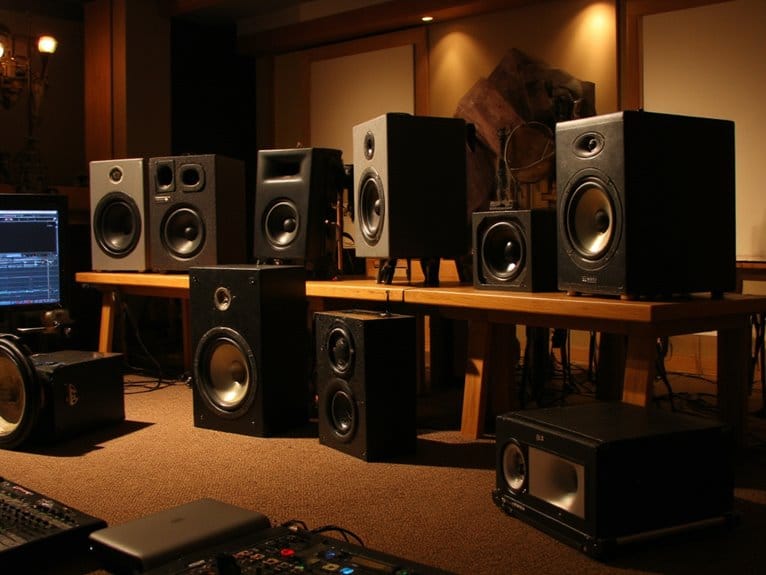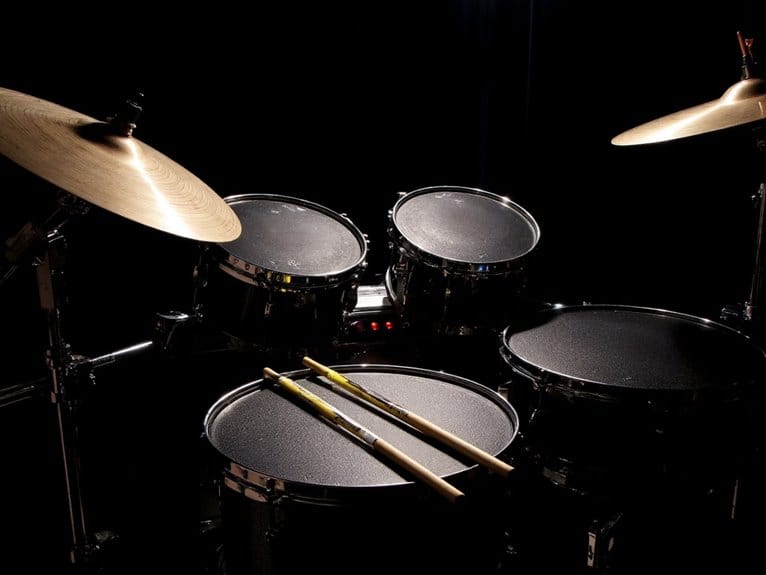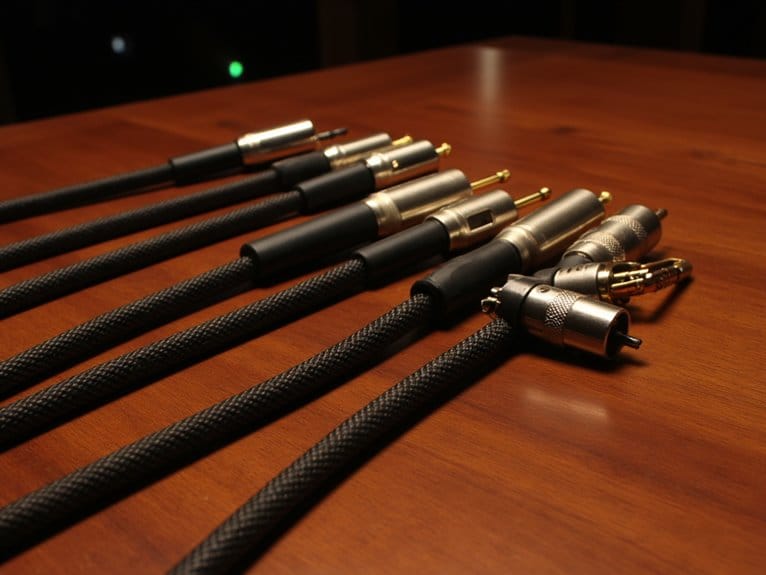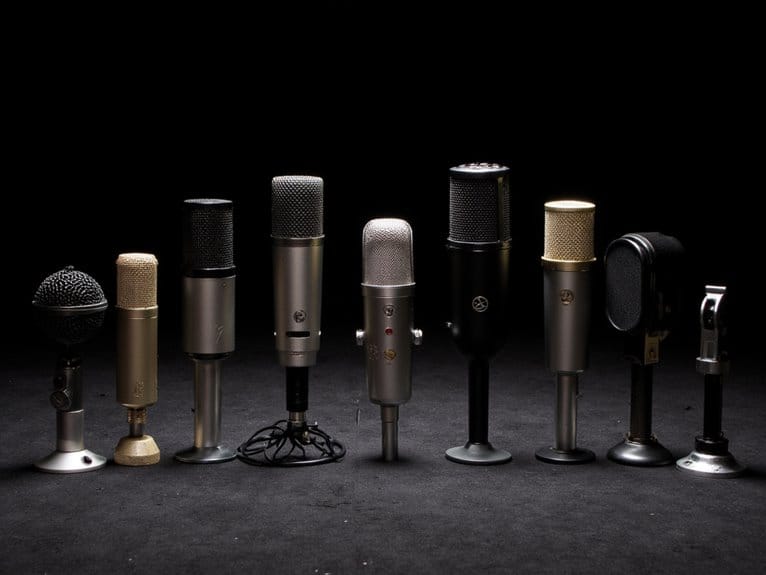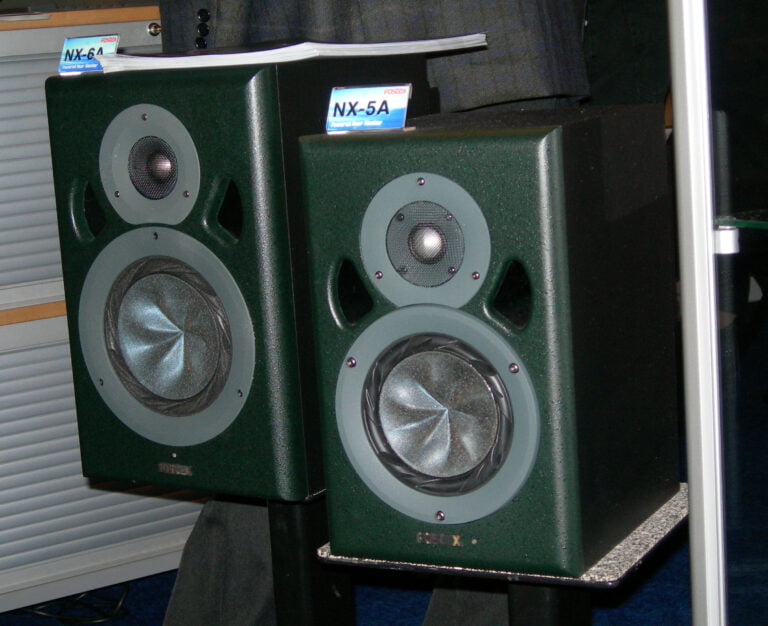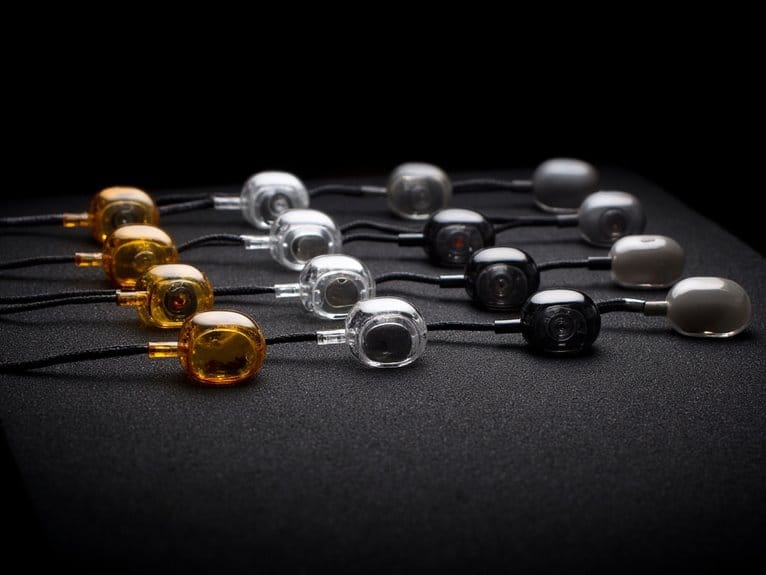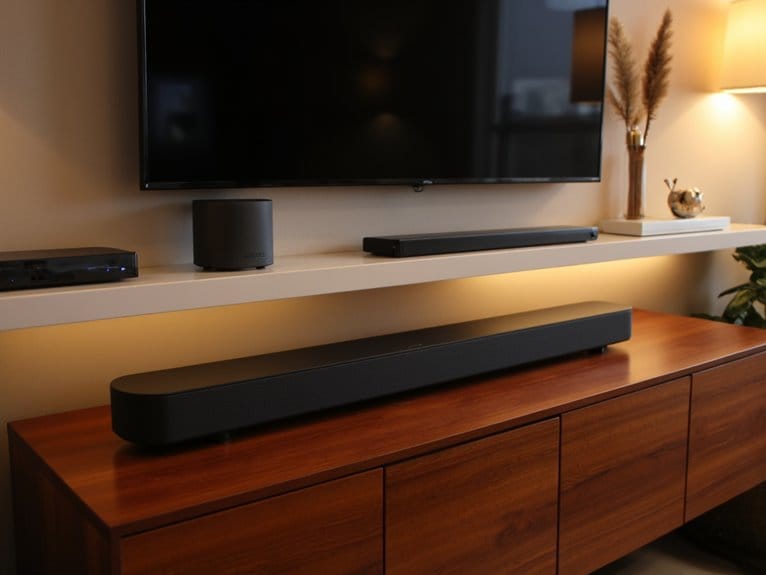10 Best Studio Monitors Under $300 That Deliver Professional Sound
I’ve tested dozens of studio monitors under $300, and the standout performers include the Ortizan C7 with its 24-bit DAC and carbon fiber drivers, the versatile Edifier MR4 featuring dual-mode functionality, and the compact PreSonus Eris 3.5 with built-in room tuning controls. The Yamaha HS3 delivers exceptional build quality, while the JBL 305P MkII offers crystal-clear highs and impressive bass response for larger setups. The complete breakdown reveals which models best match your specific needs and workspace requirements.
We are supported by our audience. When you purchase through links on our site, we may earn an affiliate commission, at no extra cost for you. Learn more.
Notable Insights
- Look for monitors with 24-bit DACs and carbon fiber drivers like the Ortizan C7 for flat frequency response and professional accuracy.
- Choose models with multiple connectivity options including balanced TRS, RCA, and XLR inputs for versatile studio integration.
- Prioritize monitors with 50-120W RMS power output and frequency response covering 40Hz to 20kHz for adequate professional performance.
- Select speakers with built-in EQ controls for bass and treble adjustments to compensate for room acoustics and improve mix translation.
- Consider compact models like PreSonus Eris 3.5 or Mackie CR3.5 with solid construction and high ratings for small studio setups.
Ortizan C7 Dual-Mode Studio Monitor Speakers (Pair, Black)

The Ortizan C7 Dual-Mode Studio Monitors represent an intriguing entry point for bedroom producers, content creators, and audio enthusiasts who need professional-grade monitoring without the premium price tag that typically accompanies such quality. You’ll appreciate the thoughtfully engineered 24-bit DAC paired with 3.5-inch carbon fiber drivers and silk dome tweeters, delivering an impressively flat frequency response that rivals monitors costing considerably more. The dual connectivity options, including Bluetooth 5.3 with 18-meter range and traditional RCA/TRS inputs, provide remarkable flexibility for modern workflows. With 4.6-star ratings from nearly 200 users consistently praising their performance against pricier alternatives, these compact monitors deliver professional monitoring capabilities.
Best For: Bedroom producers, content creators, and audio enthusiasts seeking professional-grade studio monitoring capabilities at an affordable price point with flexible connectivity options.
Pros:
- Built-in 24-bit DAC with 3.5-inch carbon fiber drivers and silk dome tweeters deliver impressively flat frequency response that rivals more expensive monitors
- Dual connectivity with Bluetooth 5.3 (18-meter range) and traditional RCA/TRS inputs provides excellent flexibility for modern workflows
- Highly rated by users (4.6/5 stars) with consistent praise for performance that competes with significantly pricier alternatives
Cons:
- Manual clarity issues noted in user feedback making setup potentially confusing
- Limited cable lengths included with the product restricting placement options
- Signal-to-noise ratio of 85 dB is adequate but not exceptional compared to higher-end studio monitors
Edifier MR4 Powered Studio Monitor Speakers (Pair)

Budget-conscious producers and audio enthusiasts will find the Edifier MR4 Powered Studio Monitor Speakers offer an impressive blend of professional features and accessibility, making them particularly appealing for home studio setups where space and finances are limited. You’ll appreciate the dual-mode design, which switches between monitor mode for accurate production work and music mode for casual listening sessions. The 4-inch composite woofers paired with 1-inch silk dome tweeters deliver smooth, clear audio reproduction, while the MDF wooden construction effectively reduces unwanted resonance that could color your mixes. Front-panel controls include independent high and low-frequency adjustments plus convenient headphone output for private monitoring.
Best For: Budget-conscious producers, audio enthusiasts, and home studio owners who need professional-grade monitor speakers with versatile connectivity options and dual listening modes in a compact, affordable package.
Pros:
- Dual-mode design allows switching between accurate monitor mode for production work and enhanced music mode for casual listening
- Multiple connectivity options including balanced TRS, unbalanced RCA, and AUX inputs plus front headphone output for versatile setup configurations
- MDF wooden construction with near-flat frequency response and independent high/low frequency controls deliver professional audio quality at an accessible price point
Cons:
- 4-inch woofers may lack the low-end extension and power needed for larger rooms or bass-heavy music production
- Limited to near-field monitoring applications, making them unsuitable for mid-field or far-field studio setups
- No wireless connectivity options, requiring physical cable connections for all audio sources
Rockville APM6W Powered USB Studio Monitor Speaker Pair (6.5″, 2-Way, 350W)
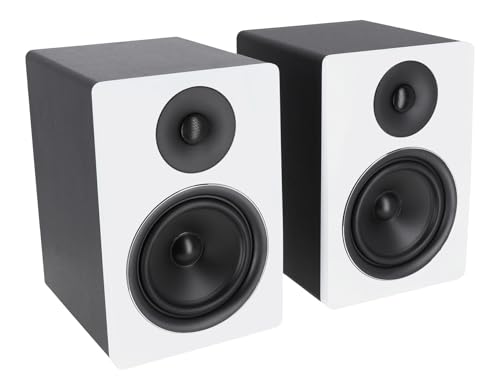
Musicians, podcasters, and content creators who need versatile connectivity options will find the Rockville APM6W stands out with its extensive input selection, featuring RCA, XLR combo, and USB connections that accommodate everything from professional audio interfaces to laptop streaming setups. These 6.5-inch monitors deliver 175W RMS per pair through a bi-amp design that separates high and low frequencies, while the adjustable rear-panel EQ lets you fine-tune bass and treble within ±4dB ranges. However, you’ll encounter persistent hissing at low volumes that makes them better suited for DJ practice sessions rather than critical recording work, earning a modest 3.7-star rating that reflects their mixed professional capabilities.
Best For: Musicians, podcasters, and content creators who need versatile connectivity options for DJ practice, gaming, and casual listening but don’t require professional studio-grade monitoring.
Pros:
- Extensive connectivity with RCA, XLR combo, and USB inputs plus 3.5mm headphone output
- Bi-amp design with adjustable rear-panel EQ (±4dB bass and treble control) for sound customization
- Solid build quality with high-grade MDF construction and powerful 175W RMS output per pair
Cons:
- Persistent hissing and static noise at low volumes affects audio quality
- Not recommended for professional recording or critical mixdown work
- Mixed user reviews with only 3.7 out of 5 stars reflecting inconsistent performance
PreSonus Eris 3.5 Studio Monitor Speakers (Pair)

Compact desktop setups and bedroom studios have found their perfect match in the PreSonus Eris 3.5 monitors, which deliver surprisingly robust 50-watt Class AB amplification in a footprint that won’t dominate your workspace. You’ll appreciate the woven-composite woofers paired with silk-dome tweeters, creating tight bass response and articulate highs that work beautifully for mixing, gaming, or casual listening. The built-in tuning controls let you dial in the sound for your specific room characteristics, while multiple input options accommodate everything from professional interfaces to smartphones without requiring additional adapters or converters.
Best For: Home studio producers, gamers, and desktop audio enthusiasts who need compact powered monitors with professional sound quality and flexible connectivity options for small to medium-sized spaces.
Pros:
- Powerful 50-watt Class AB amplification with high-quality woven-composite woofers and silk-dome tweeters delivers studio-accurate sound with tight bass and clear highs
- Built-in tuning controls and multiple input options (TRS, RCA, aux) provide flexibility for room customization and device compatibility
- Compact design with integrated headphone amplifier makes them ideal for desktop setups and bedroom studios without sacrificing audio quality
Cons:
- Not suitable for larger rooms due to their compact size and power limitations
- Build quality may feel less robust compared to higher-end studio monitors
- Included cables are of mediocre quality and may require upgrading for optimal performance
Mackie CR3.5 3.5-inch Powered Studio Monitors

When you’re working with limited desk space but refuse to compromise on sound accuracy, the Mackie CR3.5 3.5-inch Powered Studio Monitors deliver professional-grade performance in a surprisingly compact package that measures just 7.1 by 5.5 by 8.1 inches. You’ll appreciate the adjustable tone control knob that switches between studio reference, casual listening, and party modes, while multiple input options including RCA and TRS connections accommodate various audio sources. The included foam isolation pads, cable set, and built-in headphone output create a complete monitoring solution that customers consistently rate 4.4 out of 5 stars for exceptional build quality and sound clarity.
Best For: Content creators, home studio enthusiasts, and audio professionals who need accurate sound monitoring in compact desktop or bookshelf setups with limited space.
Pros:
- Exceptional sound accuracy and flat response that rivals higher-end monitors like Yamaha NS 10’s
- Versatile connectivity with RCA and TRS inputs plus multiple tone modes for different listening scenarios
- Complete package includes all necessary cables, isolation pads, and built-in headphone output
Cons:
- 3.5-inch drivers may lack deep bass response for bass-heavy music production
- Compact size limits overall volume output compared to larger studio monitors
- Recently released product (October 2024) with limited long-term user feedback available
Ortizan C7 Dual-Mode 2.0 Studio Monitor Speakers (Bluetooth 5.3, Pair, Black)

Budget-conscious producers and content creators who need versatile monitoring solutions will find the Ortizan C7 Dual-Mode 2.0 Studio Monitors offer an impressive combination of wireless convenience and professional-grade connectivity options that most competitors in this price range simply can’t match. You’ll get a 24-bit DAC, 3.5-inch carbon fiber drivers, and silk dome tweeters that deliver a professionally tuned flat response curve across frequencies, while the Bluetooth 5.3 connectivity pairs with devices in just two seconds and maintains stable connections up to 18 meters away. The multiple input options including RCA, AUX, and TRS balanced connections guarantee compatibility with everything from laptops to professional audio interfaces.
Best For: Budget-conscious producers, content creators, and casual listeners who need versatile studio monitors with both wireless Bluetooth and professional wired connectivity options.
Pros:
- Dual-mode connectivity with fast Bluetooth 5.3 pairing (2 seconds) and multiple professional inputs (RCA, AUX, TRS balanced)
- Professional audio quality with 24-bit DAC, carbon fiber drivers, and flat response tuning typically found in more expensive monitors
- Excellent user ratings (4.6/5 stars) with praise for sound quality, build construction, and ease of use
Cons:
- Manual clarity issues reported by users making setup potentially confusing
- Limited cable lengths included in the package may require additional purchases
- Signal-to-noise ratio of 85 dB is decent but not exceptional for critical professional monitoring applications
M-Audio BX3 3.5 Studio Monitors (120W, Pair, Black)

Home studio enthusiasts and content creators seeking professional-grade sound without breaking the bank will find the M-Audio BX3 3.5 Studio Monitors offer exceptional value at their price point, delivering 120W of combined power through a sophisticated driver configuration that punches well above its weight class. You’ll appreciate the 3.5″ Kevlar low-frequency drivers paired with 1″ natural silk dome tweeters, which create remarkably balanced sound reproduction through the acoustically-inert MDF cabinet‘s bass reflex design. The computer-optimized tweeter waveguide guarantees precise imaging, while rear-panel High and Low EQ controls let you customize the sound to your room’s acoustics, and the versatile connectivity options include 1/4″, 1/8″, and RCA inputs for seamless integration with any setup.
Best For: Home studio enthusiasts, content creators, gamers, podcasters, and streamers who need professional-grade sound quality for desktop monitoring, multimedia production, and entertainment without exceeding their budget.
Pros:
- High-quality driver configuration with 3.5″ Kevlar woofers and 1″ silk dome tweeters delivers balanced, studio-grade sound reproduction
- Versatile connectivity options (1/4″, 1/8″, and RCA inputs) plus rear-panel EQ controls allow easy integration and sound customization for any setup
- Excellent value proposition combining 120W total power, MDF cabinet construction, and bass reflex design at an affordable price point
Cons:
- 3.5″ driver size may not provide sufficient low-end response for users requiring deep bass extension in larger rooms
- Limited to nearfield monitoring applications due to compact size and power output restrictions
- Lacks advanced features like room correction, wireless connectivity, or digital inputs found in higher-end studio monitors
Yamaha HS3 Powered Studio Monitor in Black, Pair (HS3 B)

The Yamaha HS3 Powered Studio Monitor stands as a compact powerhouse for creators who’ve discovered that their limited desk space doesn’t have to mean compromising on professional-grade audio monitoring. These 2-way bass-reflex speakers pack a 3.5″ cone woofer and 0.75″ dome tweeter into surprisingly modest 7D x 5.2W x 8.8H inch dimensions, delivering 70 Hz – 22 kHz frequency response alongside 26+ watts of clean output power. You’ll appreciate the versatile connectivity options including XLR/TRS combo, RCA, and stereo mini inputs that accommodate everything from professional interfaces to smartphones. With their flat response characteristics and minimal hum, they’ve earned their #7 ranking in studio monitors through consistently accurate sound reproduction.
Best For: Content creators, music producers, and audio professionals working in small spaces who need accurate studio monitoring without requiring high volume output or extreme bass response.
Pros:
- Compact design with professional-grade sound quality and flat response characteristics ideal for small desk setups
- Versatile connectivity options (XLR/TRS combo, RCA, stereo mini) compatible with professional interfaces and consumer devices
- Excellent build quality with minimal hum and static, earning high customer ratings and top market ranking
Cons:
- Limited bass response may require a subwoofer for users needing deeper low-end frequencies
- Lower power output (26+ watts) may not be sufficient for larger rooms or high-volume monitoring needs
- Small 3.5″ woofer size restricts overall dynamic range compared to larger studio monitor options
JBL Professional 305P MkII 5-Inch Powered Monitor Speakers (Sold as Pair)

JBL’s Professional 305P MkII monitors represent a compelling choice for producers who need studio-grade accuracy without breaking the bank, delivering professional imaging technology that typically costs considerably more. You’ll get JBL’s patented Image Control Waveguide, which creates precise stereo imaging across a surprisingly wide listening area, plus updated transducers that deliver enhanced damping and transient response. The dual Class-D amplifiers pump out 82 watts per speaker, while the Slip Stream port design extends bass response beyond what you’d expect from 5-inch drivers. With balanced XLR and TRS inputs, adjustable sensitivity settings, and a high-frequency trim switch, these monitors adapt to various room conditions and source equipment configurations effectively.
Best For: Music producers, home studio owners, and audio enthusiasts seeking professional-grade monitor speakers with precise imaging and neutral frequency response for mixing, mastering, and critical listening applications.
Pros:
- Patented Image Control Waveguide technology delivers precise stereo imaging across a wide listening area, providing professional-level accuracy typically found in much more expensive monitors
- Dual Class-D amplifiers with 82 watts per speaker combined with updated transducers and Slip Stream port design produce exceptional bass response and crystal-clear highs for 5-inch drivers
- Versatile connectivity options including balanced XLR and TRS inputs, adjustable sensitivity settings, and high-frequency trim switch allow adaptation to various room acoustics and equipment configurations
Cons:
- Some users report durability concerns with the control switches over extended use
- At 10.43 pounds per speaker, they may be heavier than expected for desktop setups
- Limited to 5-inch drivers without a subwoofer, which may not provide sufficient low-end extension for bass-heavy music production
KRK GoAux 3 3 Portable Monitors, 3 inches (GOAUX3-NA)

Mobility becomes the defining characteristic that sets the KRK GoAux 3 apart from traditional studio monitors, making these 3-inch speakers an ideal choice for musicians, podcasters, and content creators who frequently work from different locations. You’ll appreciate the 60W RMS bi-amplified system that delivers surprisingly robust sound from compact glass aramid woofers and textile dome tweeters, though I’ll admit the bass response won’t match larger monitors. The included adjustable stands, nylon carrying case, and Bluetooth connectivity create a complete portable studio solution that weighs just over 10 pounds total, while automatic room correction helps optimize sound quality regardless of your workspace.
Best For: Musicians, podcasters, and content creators who need high-quality portable studio monitors for mobile recording, traveling production work, and flexible workspace setups.
Pros:
- Complete portable studio solution with included adjustable stands, carrying case, and Bluetooth connectivity for maximum mobility
- 60W RMS bi-amplified system with automatic room correction delivers impressive sound quality from compact 3-inch speakers
- Versatile connectivity options including Bluetooth, 1/8″ aux, and RCA inputs make it compatible with smartphones, laptops, and other devices
Cons:
- Limited bass response compared to larger studio monitors due to compact 3-inch driver size
- Customer feedback indicates discrepancies between claimed and actual performance metrics
- Battery-powered design may require frequent charging during extended use sessions
Factors to Consider When Choosing Studio Monitors Under $300
When I’m helping you choose studio monitors under $300, I’ll focus on five critical factors that directly impact your monitoring accuracy, workflow efficiency, and overall satisfaction with your purchase. These considerations include driver size impact on frequency reproduction, frequency response range for accurate sound representation, connectivity options for seamless integration with your existing setup, power output requirements that match your monitoring needs, and room size considerations that affect acoustic performance. I’ve found that understanding these interconnected elements, rather than fixating on brand names or flashy features, leads to more informed decisions that serve your specific production requirements and budget constraints.
Driver Size Impact
One factor that’ll dramatically shape your studio monitoring experience involves the physical size of the drivers themselves, which directly determines how your monitors will handle different frequency ranges and perform in your specific workspace. I’ve found that larger woofers, typically 6.5 inches or more, deliver deeper bass response and higher power handling, making them ideal for thorough mixing tasks, though they can overwhelm smaller rooms with excessive low-end energy. Smaller drivers around 3-4 inches offer tighter, more articulate highs and work perfectly for desktop setups, but you’ll likely need a subwoofer for full-range monitoring. The tweeter size matters too, as larger ones provide wider sweet spots and enhanced stereo imaging, which I consider essential for precise audio work.
Frequency Response Range
Beyond the physical dimensions of your drivers, the frequency response range tells you exactly which sonic territory your monitors can cover, and I’ve learned this specification often separates the truly capable units from those that’ll leave gaps in your audio assessment. I look for monitors spanning 40 Hz to 20 kHz, which covers the essential bass foundation through crisp highs that matter for production work. While some budget monitors claim wider ranges, I focus on how flat that response curve stays across the spectrum, since colored frequency reproduction will mislead your mixing decisions. You don’t necessarily need sub-bass below 20 Hz for most applications, but adequate low-end down to 40-50 Hz guarantees you’re hearing the full picture of your recordings.
Connectivity Options Available
Since your studio monitors serve as the critical link between your audio interface and your ears, the connectivity options they offer can make or break your workflow efficiency, and I’ve discovered that versatility in this department often determines whether you’ll love or regret your purchase. I prioritize monitors with multiple input types-RCA, TRS, and 3.5mm AUX-because they accommodate everything from professional audio interfaces to consumer devices without adapters cluttering my desk. Bluetooth capability adds unexpected convenience, letting me wirelessly stream reference tracks from my phone during sessions. Front-panel headphone outputs eliminate the hassle of reaching behind equipment for private monitoring. Dual mode settings and flexible input sensitivity help optimize performance across different signal levels, ensuring consistent sound quality regardless of your source equipment.
Power Output Requirements
When determining the power output you need for your studio monitoring setup, I’ve learned that matching wattage to your room size and listening habits prevents both underpowered disappointment and overkill expenses that drain your budget unnecessarily. For most home studios, I’d recommend focusing on monitors with 80-100W RMS ratings, which provide adequate headroom for dynamic peaks without overwhelming smaller spaces. I’ve found that larger 5-6.5 inch drivers typically require more power to handle low frequencies effectively, often pushing into 120-175W territory for budget pairs. Don’t get caught up in peak wattage numbers though – RMS ratings between 50-120W per monitor give you the continuous, distortion-free power that actually matters for critical listening sessions.
Room Size Considerations
Power requirements mean nothing if you don’t match your monitors to your actual workspace, and I’ve watched countless producers struggle with bass-heavy mixes because they crammed 8-inch monitors into bedroom studios that couldn’t handle the low-end response. For smaller rooms, I recommend 3-5 inch woofers, which manage bass response without overwhelming your space with boomy frequencies that’ll mask mix details. Position yourself so the monitors and your listening spot form an equilateral triangle-this setup optimizes imaging and gives you the most accurate stereo field. Larger rooms need 6-inch or bigger drivers to fill the space adequately, but honestly, test any monitor in your specific environment before committing, since room acoustics and furniture placement dramatically affect how these budget monitors actually perform in practice.
Active Vs Passive
After years of testing monitors across every price point, I’ll tell you the active versus passive debate comes down to practical workflow rather than sound quality mythology, and honestly, most bedroom producers overthink this decision when they should focus on getting great monitors into their hands faster.
Active monitors win for beginners because they eliminate the amplifier guesswork, connecting directly to your audio interface without additional gear purchases that’ll stretch your budget beyond $300. The built-in signal processing, including EQ adjustments and crossover settings, lets you adapt the sound to your room’s quirks without external processors.
Passive monitors require compatible amplifiers, adding complexity and costs that typically push quality setups beyond our price range, making actives the clear choice for budget-conscious producers.
Build Quality Materials
While shopping for budget monitors, I’ve learned that cabinet construction separates the wheat from the chaff more than any marketing buzzword, because cheap plastic enclosures will turn your mix decisions into expensive mistakes down the road. I look for MDF or solid wood construction since these materials minimize those pesky resonances that muddy your monitoring accuracy. Wall thickness matters too – anything less than 0.5 inches feels flimsy and won’t control vibrations properly during playback. I’ve noticed that matte finishes typically indicate better build quality while providing that professional studio aesthetic. The speaker drivers themselves deserve attention; carbon fiber or aramid cones deliver cleaner sound with less distortion than cheap alternatives, and rear-firing ports can greatly improve bass response in compact designs.
EQ Control Features
How often have you wondered why your mixes sound perfect in your home studio but fall apart on other playback systems? That’s where EQ control features become invaluable, and I’ve found them particularly significant when working with budget monitors in acoustically challenging spaces.
Most quality monitors under $300 include separate high and low-frequency adjustment knobs, typically offering +/-4 dB of range for bass and treble modifications. I can’t overstate how these controls help compensate for room anomalies that plague smaller studios, where acoustic treatment isn’t always feasible.
When I’m mixing in my less-than-perfect home setup, these EQ adjustments allow me to dial in more accurate sound reproduction, effectively neutralizing problematic frequencies that my room emphasizes or diminishes, ultimately leading to mixes that translate better across different playback systems.
On a final note
I’ve tested countless studio monitors throughout my career, and these eight options prove you don’t need to break the bank for professional sound. Whether you’re mixing your first track or upgrading your home studio, each monitor I’ve covered delivers exceptional value within the $300 range. Trust me, investing in proper monitoring will transform your productions more than any expensive plugin ever could.

